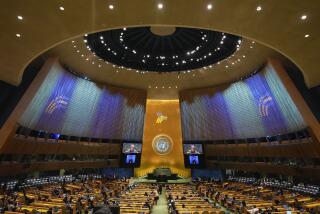Epidemic of Hope
- Share via
For as long as people have set down their thoughts, spring has been the season of hope, of which there is an abundance in much of the world this week.
In Nicaragua, seven years of killing may come to an end under a cease-fire negotiated between the Sandinista government and the U.S.-backed Contra guerrilla forces that have been trying to sweep the government out of power. The truce is temporary, but the fact that even a brief pause in the killing seemed out of the question a month ago is cause for hope that leaders on both sides can make it permanent.
There is hope that the most sweeping arms-control treaty of the nuclear age may be signed this spring, made possible by Wednesday’s confirmation that there will be a summit meeting in Moscow in late May between President Reagan and Soviet General Secretary Mikhail S. Gorbachev. The summit meeting is certain. A treaty-signing ceremony depended on the technician’s finding words to express a decision to cut long-range-missile stocks in both countries by half and to provide guarantees against cheating. If a treaty is not signed in Moscow, the President has said, it certainly can be signed before he leaves office.
In Afghanistan, disagreements over the timing of a suspension of aid from the Soviet Union and the United States to combatants in that nation’s guerrilla war block the start of an announced Soviet withdrawal of 115,000 troops. But, in the public shorthand of diplomacy, Soviet Foreign Minister Eduard A. Shevardnadze seemed to be trying to say during his Washington visit that it was all right to hope for a breakthrough even there.
These developments leave large parts of the world still hopelessly caught up in slaughter. Iran and Iraq remain horribly at war, death squads still prowl El Salvador, and there is no sign of peace either for the Middle East or for Northern Ireland. But it is possible to be thankful for any hope at all that the world learns from its brutal experiences.
There is no particular spring mystique about the hopeful signs. All represent decisions made by leaders, some in the dead of winter, that one policy or another had failed to yield hope and that it was time to try something different.
The Nicaraguan rebels have been cut off from American arms and ammunition that sustained them in battle for about seven years. Their best hope lies in trying to bargain their way back into the system. As for Nicaragua’s President Daniel Ortega, the survival of his nation is at stake. Its economy is on the edge of collapse, and his best hope of recovering is to welcome the Contras back into the system as the price of ending the war so that Nicaragua can devote full attention to raising its living standards.
With Contra and Sandinista leaders sharing a podium, singing Nicaragua’s national anthem together and pledging on both sides to make the 60-day truce work, it was hard to remember that in the recent past they could not even agree on what to discuss if they ever showed up for a meeting.
It is sometimes as difficult to remember that the President Reagan who will head for Moscow in a little more than a month is the same President Reagan who a few years ago railed at the Soviet Union as the “evil empire.”
The difference is that the old policies were not working. The nuclear age perversely made the superpowers less secure as they became more powerful militarily. The ideological fight over Nicaragua was destroying the prize that both Contras and Sandinistas fought for.
Changing policies is not enough. Leaders on all sides must buckle down to making the new policies work. But they will have hope on their side.
More to Read
Sign up for Essential California
The most important California stories and recommendations in your inbox every morning.
You may occasionally receive promotional content from the Los Angeles Times.












